This is the website of Abulsme Noibatno Itramne (also known as Sam Minter).
Posts here are rare these days. For current stuff, follow me on Mastodon
|
 Author: Homer Author: Homer
Translator: Robert Fagles
Started: 18 Nov 2006
Finished: 15 Apr 2007
541p / 149d
4 p/d
My “book pile” is still in boxes and has never been unpacked and put back in order, so when I finish a book, I am somewhat making arbitrary choices for what to read next rather than going for the next thing in what is supposed to be in order. I really need to fix that. Anyway, this time I decided I wanted to read The Odyssey. First of all, quite a few years ago, before this blog existed, I had heard something on the radio about the new Fagles translation of the Odyssey. That would put this around 1996. At that time, I became interested in reading it, but decided I had to read his translation of the Illiad first. So I did at that time. And I enjoyed it quite a bit. I remember being rather excited by it. And I had intended to soon after read the Odyssey, but I never got around to it. Until now. Also, Amy was reading the Odyssey this year for school, so it seemed like a good time.
I’ll be honest, I was a little disappointed. Especially in comparison to my memories of reading the Iliad a decade ago. I remember that as being fresh and interesting with new discoveries and interesting things on most pages. I just didn’t feel that way this time. But I can pinpoint it on one thing I think. This story is much more familiar. Of course I’d read (or I was supposed to have read) the Odyssey back in school. Plus almost every story within the Odyssey has become essentiality well known bits of popular culture and have been reused as story elements in all sorts of other things. So it was all just very familiar. For the most part I knew what was coming next. It just didn’t have the same joy as reading something new for the first time, even though I hadn’t actually read this translation before… and I’m pretty sure back in school I actually only read parts of it.
What did I find most interesting? The Introduction and the Notes on the Translation. I learned new things there.
This is not to say the story itself sucks or anything, but it didn’t hold my attention and compel me on to the next page. And this is clearly seen by my reading rate. This clocked in at a really sad 4 pages per day, and that’s only after I round to the nearest whole number. It was actually more like 3.6 pages per day. Sad. Very sad.
I finished 11 books in 2006. (Filter my blog by the Books Category to see just the books.) I’ll have to pick some books I am more “in to” for the rest of the year and pick up my pace to improve that in 2007. 11 books in a year is pitiful. I used to read so much more than that. I mean, at least a book a month! Hell, even a book a week should be reasonable. I need to carve more time out of my schedule for reading.
Anyway… one more Odyssey note. I remember when I read this in school being very upset by the scene with Argos the dog. That was the one most memorable section of the whole poem for me back then. This time I expected it, and it did not have anywhere near the same emotional impact. Oh well.
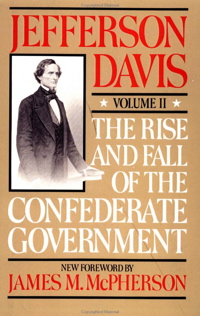 Author: Jefferson Davis Author: Jefferson Davis
Started: 10 Jul 2006
Finished: 18 Nov 2006
662p / 102d
6 p/d
The Amazon listing linked from the cover picture doesn’t say it explicitly and has the wrong cover shown, but if you look at the search inside the book you can tell it is indeed Volume 2. Anyway… I finished Volume I in November 2005. I had really enjoyed it, and this summer decided it was time to read Volume II. Volume I was about the time leading up to the Civil War, and a lot of time was spent on Davis’s analysis of the legal and constitutional underpinnings of his view of state’s rights and of the right to succession. And then continuing with a chronology of the actual succession of the various Southern states, the formation of the confederacy, the drafting of the confederate constitution, the events which led up to the start of hostilities, etc. I found all of this exceptionally fascinating. Looking at all of these things from a viewpoint that is rarely given these days.
Volume II was interesting, but no where near as much so. It was mostly about the war itself. Battles and troop movements and the ebb and flow of the war effort itself. To some, this would be the interesting part. To me, this was the least interesting aspect of the entire affair. There was a bit more of the philosophical stuff in this one, and toward the end some very interesting aspects about the beginnings of the reconstruction period and the workings of the initial Federal occupation and clamp down on the former Confederate states. But whereas MOST of the previous volume was related to these aspects that I found extremely compelling to read about, in this volume it was in the minority, and was overwhelmed by the nitty gritty of the war itself.
Even in these portions I learned quite a bit, not having done any extensive study of the civil war in the past. And it was interesting… just not as interesting to me. It was definitely worth reading for completeness. But if you had to pick just one of these two volumes, Volume I would be the one to pick.
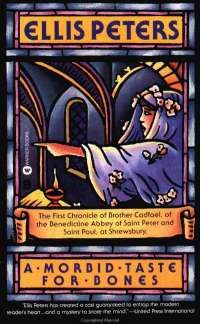 Author: Ellis Peters Author: Ellis Peters
Started: 5 Jul 2006
Finished: 10 Jul 2006
197p / 6d
33 p/d
A little delayed writing this up. I finished this on the first day the movers were packing us up in Florida. (Which reminds me, I should post some time on what a bad job they did and all the stuff that got screwed up.)
In any case, this is the first in the “Chronicles of Brother Cadfael”. A few Christmases and birthdays ago my mom had given me a Cadfael book… the LAST of the series actually. I was bad and read it before reading earlier ones in the series, but decided it was worth reading more. So I ordered the first in the series. Several years later, it made it to the top of my pile and I read it.
Basically your standard murder mystery sort of thing except it is set in the middle ages and the detective is a monk. This one centers around a quest to get the bones of a saint for the monestary and the events that end up surrounding that.
In the end it was OK, but did not super impress me. If I remember correctly (it was years ago) I liked the other one I read better. This one just never fully held my attention. It was still a pretty quick read, but I was never fully drawn in. There was never a time where I felt like I had to keep reading rather than putting it down for awhile.
I’ll still read the next one in the series (eventually). But I’m won’t be in a super rush.
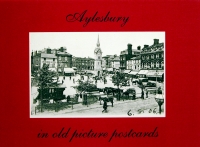 Author: Ralph May Author: Ralph May
Started: 2 Jul 2006
Finished: 5 Jul 2006
108p / 4d
27 p/d
This is one of two volumes. I’ll get to the next one before too long I imagine. I picked them up in Aylesbury during my 2002 Q1 Random Vacation. It is basically a book full of pictures of old postcards… as the title would imply. Each one captioned with a bit of history about what is shown, when it was, what has changed since then.
I actually find this sort of stuff facinating. So I was very interested. Plus of course, it was about a place I had been for my random trip. So it brought up good memories of the place. I recognized many places on the postcards even though they had often changed quite a bit.
I just read a little at a time, otherwise this would have been a one day book. It was mostly pictures after all.
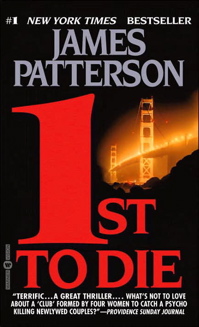 Author: James Patterson Author: James Patterson
Started: 1 Jul 2006
Finished: 2 Jul 2006
471p / 2d
236 p/d
Well, OK, I whizzed through this one kinda fast didn’t I?
First let me explain why this book is the book I read. You see, as I’ve explained before, I don’t have my whole book pile from home here. And some non-fiction books that were for work skipped ahead in line, cause they were for work and all. So I finished the non-fiction book I was reading and needed a fiction. But the next fiction in the pile had a higher number than the next non-fiction in line, and I can’t read them out of order. So I needed a fiction that did not have a number. The next fiction in the pile I had HERE that did not have a number was James Patterson’s The 5th Horseman. See, Brandy had left that here last time she visited, so it became part of my pile. But that was the 5th in the series, and you can’t start at #5, that would be wrong. So I ordered the first one and that is what became next on the list.
So… the book itself. First of all the speed is deceptive. Yes, I did 236 pages a day, which seems really high for me. But this book is printed with a big font and large margins on the pages, and is written in short uncomplicated sentences. Each chapter is only a couple of pages. It is designed to be a quick read that doesn’t require all that much thought or analysis. It just sweeps over you. It is much more like watching TV than reading really.
But, having said that, it is exactly what it is supposed to be. A quick fun read. Well, aside from the grizzly murders. But hey, that is part of the genre. It is supposed to be about four women in their little murder solving club, but three of the four really were supporting characters. It was about the first of them. Maybe that changes in the next four books in this series. Dunno.
In any case, I’ll enjoyed it. As with any book in a series I read, the next book in the series has already been ordered. And of course #5 is still in the pile, so I’ll eventually have to read the ones in between to get to it. That is just how it works.
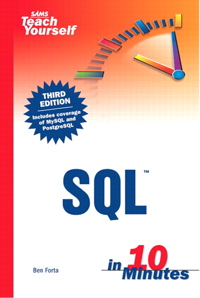 Author: Ben Forta Author: Ben Forta
Started: 21 Jun 2006
Finished: 1 Jul 2006
242p / 11d
22 p/d
Another one for work. I’d played with SQL various times before, but played was really the operative keyword. I could use things other people had done. Maybe change them slightly. Didn’t feel confident enough to do new things of my own. So I needed to get comfortable. Thus the book. I decided to get a basic level teach yourself book, and this was the bestselling at the time I ordered it.
After reading though, I think I might have gotten one that was TOO basic. There really wasn’t all that much there that couldn’t be found at dozens of online reference sites. But… having it all in a narrative provided the context I needed to go through and systematically read what I needed to read in a way I would probably not have done just looking at reference sites. Not that I could not have, but that I *would* not have. But the book made me go through it.
In any case, it was a good overview. I feel much more comfortable that I did. It still only covered basic stuff, so if I need more complex things I’ll still need need to look it up or get another book, but for the basics, it did what it was supposed to do.
Oh, and of course the “in 10 minutes” part is how long it is supposed to take for each chapter, not for the whole book. They are so tricky!
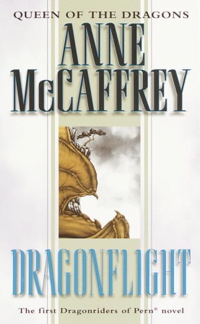 Author: Anne McCaffrey Author: Anne McCaffrey
Started: 18 Jun 2006
Finished: 21 Jun 2006
303p / 4d
76 p/d
Brandy recently read all of Anne McCaffrey’s dragon books after she ran out of books once and I pointed her at them. And so I was inspired to want to read them again for the first time in at least a decade. So, I decided to pick up the first of the bunch and read it again.
And of course, I basically couldn’t put it down. Well, of course I put it down. I went to work and stuff. I only read a couple chapters Sunday through Tuesday actually, but then early Wednesday, right around when I was supposed to be going to sleep for the night I picked up the book instead. And THEN I didn’t put it down until I was done several hours later. Leaving me quite tired during the day Wednesday after I dragged myself out of bed and to work. The 76 pages per day rate I averaged on this book is the fastest rate for anything I’ve read since I started posting books I read on this blog. Woo! Of course, in exchange, I didn’t do anything I was supposed to in the time between work and bed for a couple days (although this wasn’t the only reason) and I ended up only sleeping a couple hours one night, but hey, I wanted to read the book!
I was definitely reminded how much I like this series. And that is of course mainly because I want a dragon. I mean, who wouldn’t? I’d even settle for a fire lizard (although they were not in this book). A fire lizard would be quite fine.
I have read these much less often than I have read the Lord of the Rings, and it showed while I was reading it. There were certainly things that I remembered… but generally only a few pages before I got to them… I could not have told you the plot before I started reading it again. In fact, I would have claimed that this particular plot was actually the plot of one of the later books, not the first book, and would have been completely wrong. And even once reading it, I might remember general plot points, but not details. And that was nice. Not quite like reading something for the very first time, but still good. And like going back to an old friend. I am very tempted to just move right on to the next book in the series, but alas, there are other things ahead of it in line.
One more note… Brandy was reading many of the dragon books in the last few months of Princely’s life. A few times during those months she referred to him as “her dragon”. And that resonated while reading and added poignancy. I’ll never be able to read these books again without also thinking about Princely and shedding a tear or two. I miss him very much too.
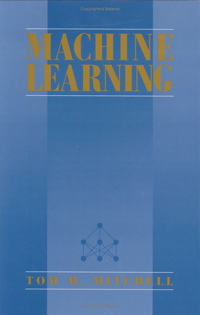 Author: Tom M. Mitchell Author: Tom M. Mitchell
Started: 25 Mar 2006
Finished: 18 Jun 2006
414p / 87d
5 p/d
This is a textbook I got for work to give me somewhat of a background in some of the technologies being used, and other related technologies that we might someday want to use. It is normally targeted at advanced undergrad CS majors or starting CS grad students. Now, I took a couple CS classes my freshman year of college, but really haven’t done much else of the sort since then. So this was a mode of thinking I hadn’t been much used to. And to be honest, even back then it was more about listening to and understanding a professor than trying to grok it by reading a book.
The first few chapters were pretty straightforward, but it did definitely get more challenging after that. And of course I wasn’t doing it the full out way trying to actually do all the exercises and such at the end of every chapter. However I was, for the most part, doing careful reading. That is, if I read a paragraph or two and then realized I didn’t fully understand what was being said, I’d go back and read it over and over again, thinking about it, until I thought I did understand. And sometimes that took a few passes. And even then, I think what I actually ABSORBED, in that I still remember after having finished the entire book, is just the general ideas for the most part, certainly not the details. If I was asked to actually do anything with any of the techniques described, I’d have to go back and read that chapter again with an even more fine tooth comb. And certainly, the further on you go in the book, the more true that is.
But it was still a good overview. Gives some good vocabulary I can use at work. And some background that helps me understand some of what the options and tradeoffs are. So it was good to have read it.
The next non-fiction will be a book for work as well. They are sneaking ahead in line of the personally chosen non-fiction. But for now, time for some light fiction…
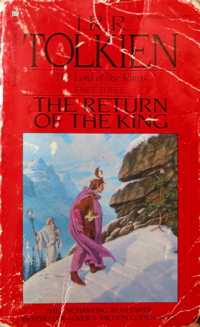 Author: J. R. R. Tolkien Author: J. R. R. Tolkien
Started: 7 Mar 2006
Finished: 25 Mar 2006
544p / 19d
29 p/d
I read Two Towers right as the Two towers movie was coming out. I had intended to finish it before the movie came out, but ended up finishing a little after. At least I think that is what happened. In any case, it was a long time ago. And my book pile has been so disrupted by the various moves, it doesn’t much resemble what it was. At the time I left Pennsylvania, this was 6th on the list. But others snuck in before they should have because things were in boxes. In any case, I finally got to it. Not quite in time for the third movie.
Of couse this is not the first time I read this. This series is one I have read many many times since my dad read me The Hobbit. It had been a number of years though. And I worried a bit that the years since I had read the last book in the series most recently would detract. But no, it didn’t. This series is still one of my favorites.
It did seem to go much faster than I remembered though. Every night I’d stop and think, wow, I got to that part already?
And as usual with the Return of the King in particular, the part that facinated me more than practically any other part was reading the extensive appendicies. The additional detail and background that gives is great. Especially the first few that give some more information on what happens to the characters after the end of the book, and then given an overview of the history of middle earth than is explored more fully in The Silmarillion. People who read this series but then skip the Appendicies are missing out!
The other thing I was acutely aware of as reading this time around was that both my copies of The Atlas of Middle-Earth were in Florida. I loved that thing too, and I kept wanting to refer to it, but didn’t have it…
One final thing to mention. The edition pictured above is the one I actually read. A copy I’ve had since sometime in the mid 80’s. The link above is to a current edition as this one is no longer in print. However, it also made me think about the copies that were the first ones I ever read. Including the copy of The Hobbit in the picture of me and my dad I linked above. Turns out while they were not from the very first print run, the versions my dad shared with me of The Hobbit, The Followship of the Ring, and the Two Towers were early enough that they had the same cover design as the first American paperback editions. And more impressive, the copy of the Return of the King was the ORIGINAL hardcover design from the UK. (Although it is missing it’s dust cover, which I vaguely remember, but have not seen since I was a child, and maybe never saw, but I think I did…) As I said, not actual first printing, but first edition if that is the right termonology… before the first time they redid the cover artwork in any case. All four of those books are at this moment in boxes in Florida. If they were in good condition they would be worth a decent amount as collectible editions. Unfortunately, they were beloved books from when I was about age 10 to when I wanted to read them at a time I didn’t have the old ones handy and bought a new copy sometime when I was a teenager. So I beat the hell out of them. All four are in pretty bad condition. The covers of the paperbacks are seperated and torn, the pages are yellowed and brittle, etc, etc. The hardcover is a bit better off, but still pretty beat up.
Anyway, whenever I find that box again, those four books are going to get put somewhere very carefully so they don’t get any worse. Cause of the condition they are already in probably not worth anything, but still fond sentamental memories for me.
In any case, great books. Silmarillian is next. Wonder how many years until I get to it.
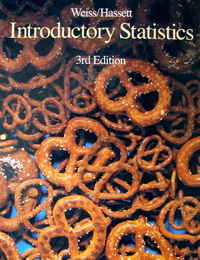 Authors: Neil A. Weiss and Matthew J. Hassett Authors: Neil A. Weiss and Matthew J. Hassett
Started: 16 Jan 2006
Finished: 7 Mar 2006
940p / 51d
18 p/d
After starting my new job, I decided a review of statistics might be in order, just to make sure I remembered all the relevant terminology and such and had the concepts fresh in my mind. I don’t actually have to DO that kind of analysis for work right now, but I certainly have to understand it. So review is good. It has been a long time since I’ve had to do this kind of stuff.
Now, I dug this particular book up from college days. Specifically the one summer between undergrad and my one abortive year of grad school. Even though I had a Physics degree, the Heinz schoiol required an actual stats class as a pre-requisite. I had used lots of stats, but never taken an actual stats class. So I signed up at the community college over the summer. There was all kinds of confusion about if I was an in state student or not and what the price was and all kinds of other things. Anyway, as it ended, although I attended all the classes, I never was officially enrolled in the class, never paid, and never got any official credit for it, and Heinz did not care and I started anyway. The class was also painfully simple. I was very bored.
In any case… the book… like the class, the whole first half of the book is painfully slow. There are chapters spent on what Means and Medians are, which arer topics Amy covered in the first half of 5th grade… I know it started at the beginning, but… so anyway it slowly gathered steam. Only the first few chapters were truly trivial. Then there were many chapters of stuff I remembered once I read it, but would have been challenged to describe cold if asked before I read the book. Then maybe the last half of the book was actually stuff I didn’t remember at all.
It frustrated me though. Not because the material was hard, but because it was all being done as a cookbook approach. “Have this kind of problem, use this procedure.” There was no derivation from first principals, and in many cases they avoided actual equations whenever possible. And there were bunches of places where if they had used calculus it would have been a lot nicer, but they were doing this at a level where algebra was enough. Now, I understand, this is the kind of bpook this is. This is a stats literacy book, not a book for math majors. So no proofs. No derivations. No detailed analysis of WHY something is done the way it is… it is just given as fact. Which has its purposes, but that always tends to frustrate me. I don’t like just being told something is some way because it is, I like to understand why.
But that would be a different textbook entirely. (And I’m not so interested that I’m going to go order one now.)
This one did its job. It refreshed my memory of various sorts of statistical analysis that I might bump into or need. Enough so I can speak about such things without being a complete idiot, and enough so I know where to look for more info if I need it.
Which is good.
But after 51 days and 940 pages of a statistics textbook, I am now quite glad the book I am now reading is a nice quick read novel…
|
|
 Author: Homer
Author: Homer







